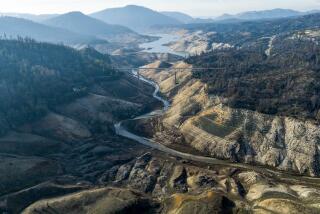Forecasters Stalk the Wild El Nino : Weather: The phenomenon is back, the third in about a decade. Experts hope to learn to predict them.
- Share via
El Nino is back, threatening to shatter the world’s normal weather patterns for the third time in less than a decade.
An El Nino--”the child” in Spanish--is a warming of tropical waters in the Pacific Ocean that occurs every three to five years. It can generate all kinds of devastating weather, from droughts in Africa to flooding in North America.
“Apart from the change in seasons, El Nino is the most important recurring event affecting world climates,” says David Rodenhuis, director of the National Weather Service’s Climate Analysis Center in Camp Springs, Md.
Experts predict that the 1991-92 El Nino will pack more punch than the last one, in 1986-87, but less than the one in 1982-83. Then, sea surface temperatures rose as much as 14 degrees Fahrenheit above normal. Readings this year show a relatively modest four-degree rise.
Weather forecasters say El Nino set the stage for the heavy rains that recently inundated the Gulf Coast and California, causing disastrous floods.
In the north, it has delivered above-normal warmth to western Canada and northern states from Washington to Minnesota. Indonesia and Australia have been drier than usual.
But so far nothing this time has matched the violence of the El Nino that began about a decade ago. The most severe in recent years, it ravaged widely separated areas such as the U.S. Gulf Coast, Ecuador, Australia and southern Africa. High winds, rampaging floods and droughts left more than 1,100 people dead and damage estimated at $8.7 billion.
Last year more than 300 Weather Service buoys, loaded with electronic equipment and floating around the equatorial Pacific, gave scientists their earliest ever advance warning of an El Nino.
Information collected from small, drifting buoys that monitor temperatures near the ocean’s surface and from large, moored buoys that measure currents and subsurface sea temperatures is beamed to satellites.
“When El Nino hit in 1982, we only had a dozen or so of these things out there,” says Richard W. Reynolds, an oceanographer at the climate center. “They’ve really made a difference in the accuracy and confidence of our predictions.”
Encouraged by the early forecast in 1991, meteorologists hope that they soon can develop models of oceanic and atmospheric conditions that give rise to the weird weather pattern.
“Linking these to a computer,” says Vernon E. Kousky, a research meteorologist at the center, “we someday hope to predict an El Nino even before the first symptoms appear.”
El Nino takes its name from an allusion to the Christ child, because South Americans often feel its warm ocean currents around Christmastime.
The phenomenon usually peaks by early spring, and the present one probably will last through summer, Kousky predicts. “In the last stages, the only place affected will probably be northern India, with drier-than-normal conditions,” he says.
El Ninos sometimes cause heavy rain in the southeastern United States and can make the hurricane season there milder than usual. They warm up western Canada.
They often cause droughts in Indonesia, Australia, India and parts of Brazil. Sections of South America, such as the coastal regions of Peru and Ecuador, can get too much rain.
El Ninos have been around for at least 2,500 years, says Miriam R. Steinitz-Kannan, a biologist at Northern Kentucky University, whose work has been supported by the National Geographic Society. She made her findings after examining and dating deep sediment cores from an Andean lake in a region of Ecuador that is often hard hit by El Ninos.
The cores taken from the Andes site and from lakes in the Galapagos Islands off the coast of Ecuador show that freshwater diatoms, a type of microscopic algae, thrive in such places during and immediately after El Nino years because heavy rainfall displaces the normally salty water.
“So far it looks as if severe El Ninos have occurred less frequently in the last 500 years,” Steinitz-Kannan says.
Trigger mechanisms for El Ninos usually come into play during the spring or autumn, when world weather systems are shifting.
“There are two of these features that dominate the tropics and subtropics during crucial times of the year,” Kousky explains. “One is the monsoon that dominates Southeast Asia and India during our summer, and the other is the Australian monsoon that influences that region during our winter.
“El Ninos seem to evolve when these two monsoons are in transition, moving cloudiness and precipitation around during our spring and fall. And, true to form, we first noticed the symptoms of the current one last spring and were able to confirm it by November.”






